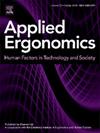Real-time motion sickness measurement: Feasibility and application of the real-time motion sickness scale (RMS)
IF 3.1
2区 工程技术
Q2 ENGINEERING, INDUSTRIAL
引用次数: 0
Abstract
Motion sickness can occur in environments where new technologies, such as electric vehicles, are applied. Since motion sickness impedes user experience and the adoption of these technologies, accurate prediction is essential. This necessitates precise measurement of motion sickness variations across different environments to improve predictive model accuracy. However, current questionnaires lack detailed temporal and symptom-specific information, failing to provide accurate real-time data. To address this, we introduce the Real-Time Motion Sickness Scale (RMS), a practical tool designed for continuous monitoring of significant motion sickness symptoms. The RMS was developed by enhancing existing questionnaires through a systematic literature review and pilot tests. We validated its feasibility through a real-driving experiment with 24 passengers in an electric vehicle. The results demonstrated that the RMS accurately describes motion sickness severity and captures real-time changes in detail. Based on these findings, we discuss the applications of the RMS in motion sickness-provocative environments.
实时晕动病测量:实时晕动病量表的可行性及应用
晕动病可能发生在使用新技术的环境中,比如电动汽车。由于晕动病阻碍了用户体验和对这些技术的采用,因此准确的预测至关重要。这就需要在不同的环境中精确测量晕动病的变化,以提高预测模型的准确性。然而,目前的问卷缺乏详细的时间和特定症状信息,无法提供准确的实时数据。为了解决这个问题,我们引入了实时晕动病量表(RMS),这是一个实用的工具,旨在持续监测显著的晕动病症状。RMS是通过系统的文献回顾和试点测试来改进现有问卷而制定的。我们通过24名乘客乘坐电动汽车的真实驾驶实验验证了其可行性。结果表明,RMS准确地描述了晕动病的严重程度,并捕获了实时变化的细节。基于这些发现,我们讨论了RMS在运动病诱发环境中的应用。
本文章由计算机程序翻译,如有差异,请以英文原文为准。
求助全文
约1分钟内获得全文
求助全文
来源期刊

Applied Ergonomics
工程技术-工程:工业
CiteScore
7.50
自引率
9.40%
发文量
248
审稿时长
53 days
期刊介绍:
Applied Ergonomics is aimed at ergonomists and all those interested in applying ergonomics/human factors in the design, planning and management of technical and social systems at work or leisure. Readership is truly international with subscribers in over 50 countries. Professionals for whom Applied Ergonomics is of interest include: ergonomists, designers, industrial engineers, health and safety specialists, systems engineers, design engineers, organizational psychologists, occupational health specialists and human-computer interaction specialists.
 求助内容:
求助内容: 应助结果提醒方式:
应助结果提醒方式:


